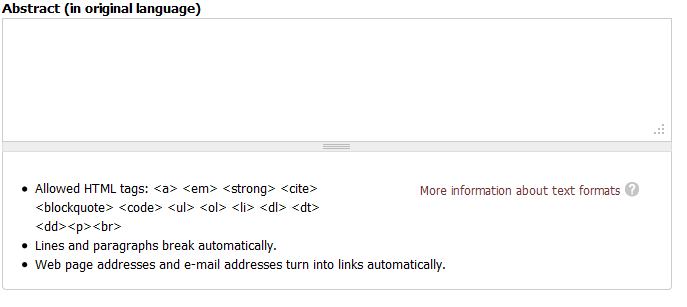ELMCIP User's Guide
3.3 - Description
On this page, enter descriptive information that will provide other users a sense of what a work of critical writing is about and contextualize it within the larger field of electronic literature and the digital literary arts.
Tags: A comma-separated list of terms, keywords, or phrases that describe and/or contextualize this piece of critical writing. Some tags may be similar to the subject headings assigned by librarians. Examples: digital poetry -- history and criticism, digital poetics, procedural poetics, generative, intentionality, materiality.

How can I come up with tags? Reading the work closely, of course, is the best way to come up with tags. But it is also possible through a more extensive, surface, reading of the text in which you're searching for keywords that help to describe the text. Often, you will find them embedded in the title of a work, in the jacket copy, or, in the case of a journal article, in the abstract.
Take Espen Aarseth's book Cybertext: Perspectives on Ergodic Literature, for instance. The book's title and sub-title contains several tags: (cybertext, ergodic, ergodic literature). Scanning the back-cover copy suggests many more: literary theory, computer games, digital literature, cyborg textuality, hypertext fiction, computer-generated poetry, collaborative, narrative theory, semiotics, and rhetoric. And the Library of Congress Cataloging-in-Publication Data, which in the 1997 paperback edition is on book's final page, provides a few more possibilites: discourse analysis, literature and technology, communication and technology.
As you begin entering your tags, the database will suggest other terms that other users have added. These suggestions are based on the characters that you type, so they may or may not apply to the work you're describing. It's usually worth scanning the list, however, as you may get new ideas, not just about what tags to apply but how this work relates to other materials in the Knowlege Base.
Abstract (in English): Enter a brief descriptive abstract describing the critical writing or article in fewer than 350 words. Ideally, the abstract should summarize the piece in a way that provides readers' a sense of what the work is about.

It is fine to cite abstracts and text from other sources. Many of the entries for books, for example, have the publisher's catalog descriptions. Just be sure to credit the source at the end of the entry. For example:
(Source: Continuum online catalog.)
(Source: Author's abstract.)
Contributors to the Knowledge Base are encouraged to revise and elaborate upon existing abstracts, much as contributors to wiki websites do.
If your revisions to an existing description are substantive and, in your judgment, significantly alter its content please explain your changes in the "revision log message," which can be accessed by clicking on the "Revision information" in the left column.
Abstract (in original language): If the work is not written in English write an abstract of fewer than 350 words in its original language of publication. Leave this field empty if the language of the work is English.

Language of abstract: If you entered an abstract for a non-English-language work, select the language in which it was originally written. If you are creating a new record, skip this field and proceed to the next, Language of abstract (Taxonomy).

Language of abstract (Taxonomy): Select the human language of the non-English-language work. Note: this taxonomy field will replace the previous Language of abstract field, which will be deleted once the data is migrated from it. For new records, disregard the other Language of abstract field above and use this one.

Other language version: If there is a record in the Knowledge Base of another version of this item published in a different language, add the reference here.

Pull quote: Enter a significant passage (1-2 sentences) excerpted from the text that will help to contextualize it. The quote may displayed on the Knowledge Base and should be representative of the text, pinpointing its primary claim(s) or identifying a key topic, so as to entice readers to access and read the work.
Do not put quotation marks around the pull quote.